Introduction
In the journey of parenthood, few challenges are as daunting as recognizing and understanding the early signs of Autism Spectrum Disorder (ASD) in infants. As research increasingly highlights the critical importance of early detection, parents are called to become vigilant observers of their child's development, especially within the first six months of life. This period can reveal crucial behavioral indicators that may point toward autism, making it essential for caregivers to be informed and proactive.
By understanding these signs and accessing the right resources, parents can not only advocate for their child's needs but also create a nurturing environment that fosters growth and development. This article delves into the early signs of autism, the significance of timely intervention, and the resources available to support parents on this journey, empowering them to navigate the complexities of autism with confidence and compassion.
Understanding Autism: Early Signs in Infants
Autism Spectrum Disorder (ASD) can manifest in various forms, often becoming apparent during initial developmental stages. Acknowledging the significance of prompt detection, particularly by around 6 months of age, can be a crucial step for parents. During this period, infants may exhibit behaviors that indicate a higher likelihood of autism, such as:
- Limited social responsiveness
- Reduced eye contact
- Lack of response to their name
- Delayed communication skills like cooing or babbling
Statistics show that approximately 1 in 6 youngsters aged 3–17 years are identified with a developmental disability, highlighting the importance of timely observation.
Recognizing these initial signs enables parents to closely observe their child's development and seek appropriate support when necessary. For instance, services for adaptive behavior, which cost an average of $82.25, and emergency department visits, costing around $1,397.22, highlight the importance of timely intervention to potentially mitigate future costs and ensure access to necessary care. Recent studies have indicated a growing pattern in the identification of developmental disorders, showcasing the importance of vigilant detection methods.
Staying informed about the latest research and real-world examples of developmental disorder detection can provide valuable guidance and reassurance. By being proactive and attentive, parents can play a crucial role in their child's developmental journey, ensuring they receive the support they need as soon as possible.
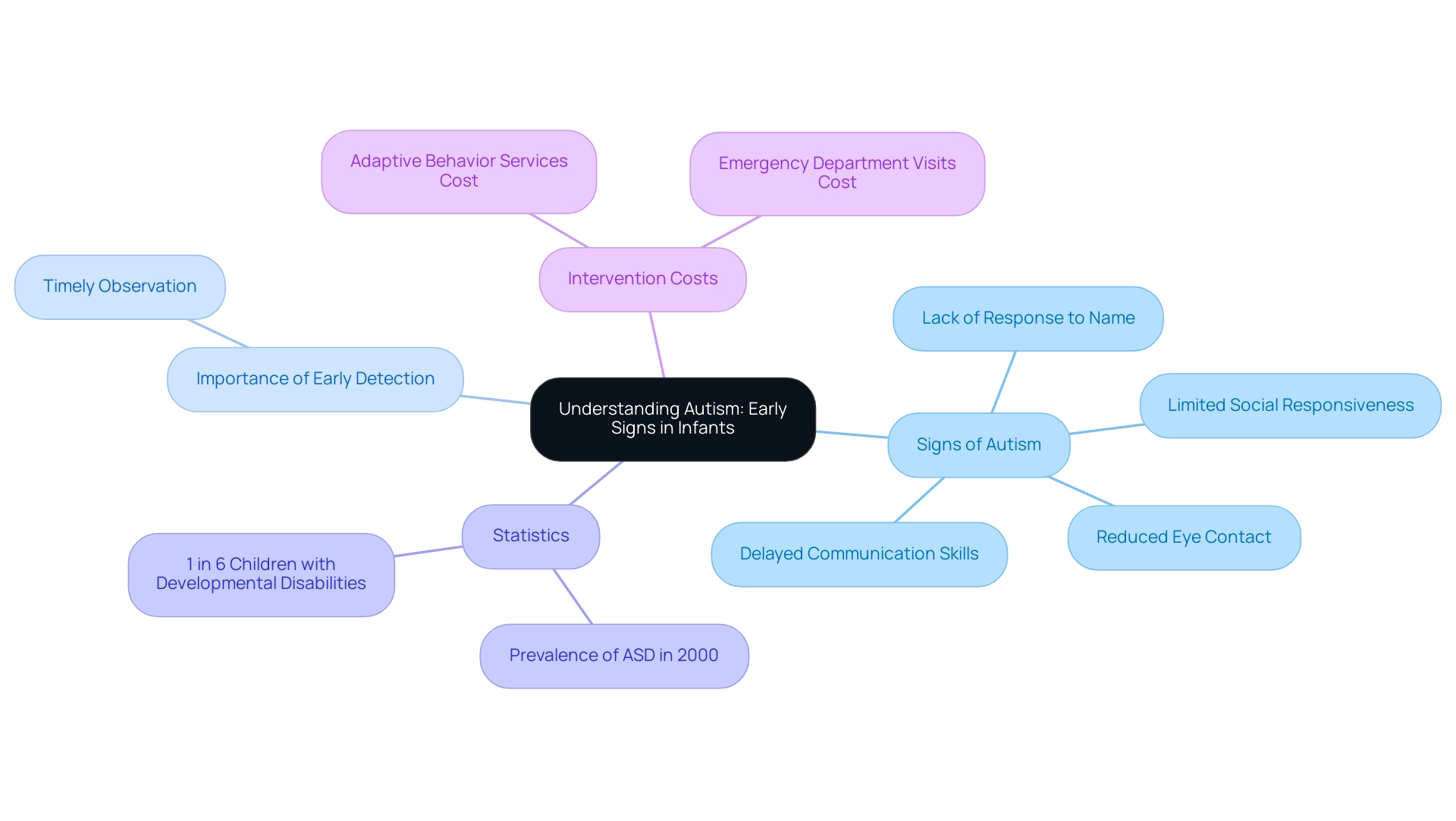
Key Behavioral Indicators of Autism in 6-Month-Olds
Identifying initial signs of autism in infants can be crucial for timely intervention. The typical age of initial developmental concerns reported by caregivers is 32 months, highlighting the significance of prompt detection. Here are several key behavioral indicators to observe in 6-month-old infants:
-
Limited Eye Contact: Eye contact is a crucial form of initial social interaction. Infants exhibiting minimal eye contact with caregivers may be demonstrating one of the early indications of a developmental disorder. Research has indicated that even at 6 and 12 months, infants who are later identified with developmental differences appear similar to typically developing children in aspects such as social smiling or gaze to faces. Yet, consistent lack of eye contact can be notable, as it often represents a divergence from typical developmental patterns.
-
Lack of Smiling or Responsive Actions: While most babies interact with their caregivers through smiles and coos, infants on the spectrum may not reciprocate these gestures as frequently. This reduced engagement can signify potential developmental differences.
-
Delayed Babbling: By six months, many infants begin to babble as part of their vocal play. A noticeable delay in this developmental milestone can be a red flag, indicating the need for further observation and possibly early intervention.
-
Unusual Reactions to Sensory Stimuli: Some infants with developmental disorders might exhibit heightened sensitivity to sensory inputs such as sounds, lights, or textures. These heightened reactions can be an important behavioral indicator, suggesting the need for closer monitoring.
-
Lack of Interest in Social Play: Autistic infants may show limited interest in interactive games like peek-a-boo, which typically captivate most babies. This lack of interest in social play can highlight differences in social engagement and interaction.
-
Hand-Flapping or Other Repetitive Movements: While some repetitive movements are typical in infants, persistent hand-flapping or other repetitive motions may indicate a need for self-soothing, often associated with autism.
Understanding these behavioral indicators empowers parents to communicate their observations with healthcare providers. Current news emphasizes the ongoing challenges in developing effective infant interventions tailored to individual needs. Addressing these signs promptly can be crucial for effective intervention, customized to meet the varied needs of each individual.
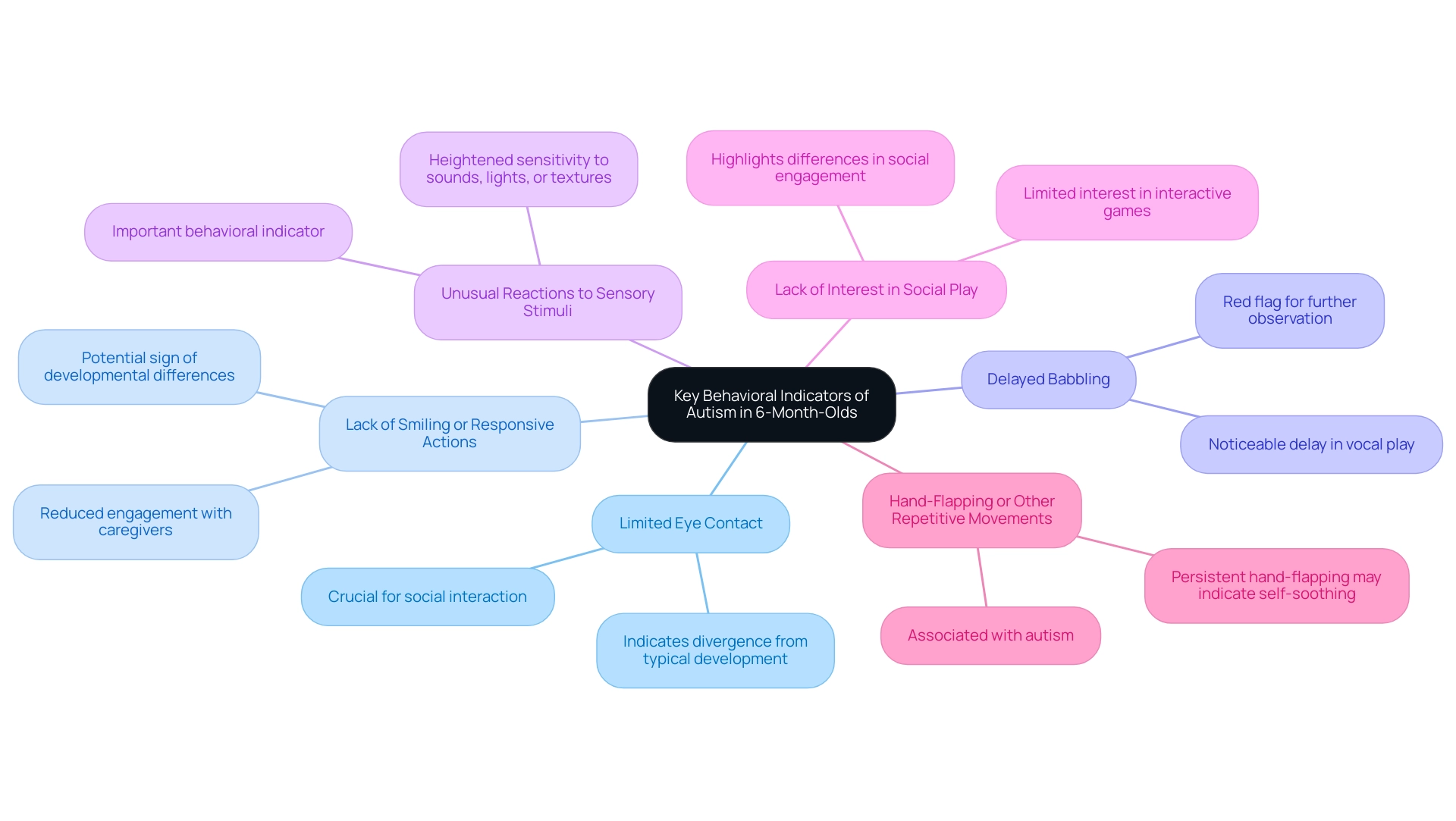
The Importance of Early Detection and Support for Autistic Infants
Early identification of the condition is crucial for providing infants with the support and interventions needed to enhance their development. Recent data indicates a notable increase in autism diagnoses, now impacting 1 in every 44 youths, emphasizing the significance of identifying initial signs. Research consistently demonstrates that the earlier a child receives help, the more effectively they can develop essential skills such as communication and social interactions.
Experts in the field emphasize that early intervention can lead to more favorable outcomes. For instance, studies such as Welterlin et al. (2012) illustrate that infants who participated in the Home Teaching Program exhibited notable improvements in cognitive ability and socialization skills compared to those on a waitlist. These findings underscore the critical nature of timely support.
Parents who notice indicators of developmental disorders in their infants should feel empowered to seek evaluations from healthcare professionals. Early support services, including Applied Behavior Analysis (ABA) therapy, provide customized strategies tailored to each individual’s needs, significantly increasing the likelihood of achieving developmental milestones. By taking prompt action, caregivers can create a nurturing environment that fosters a child's growth and equips them to navigate the complexities of autism.
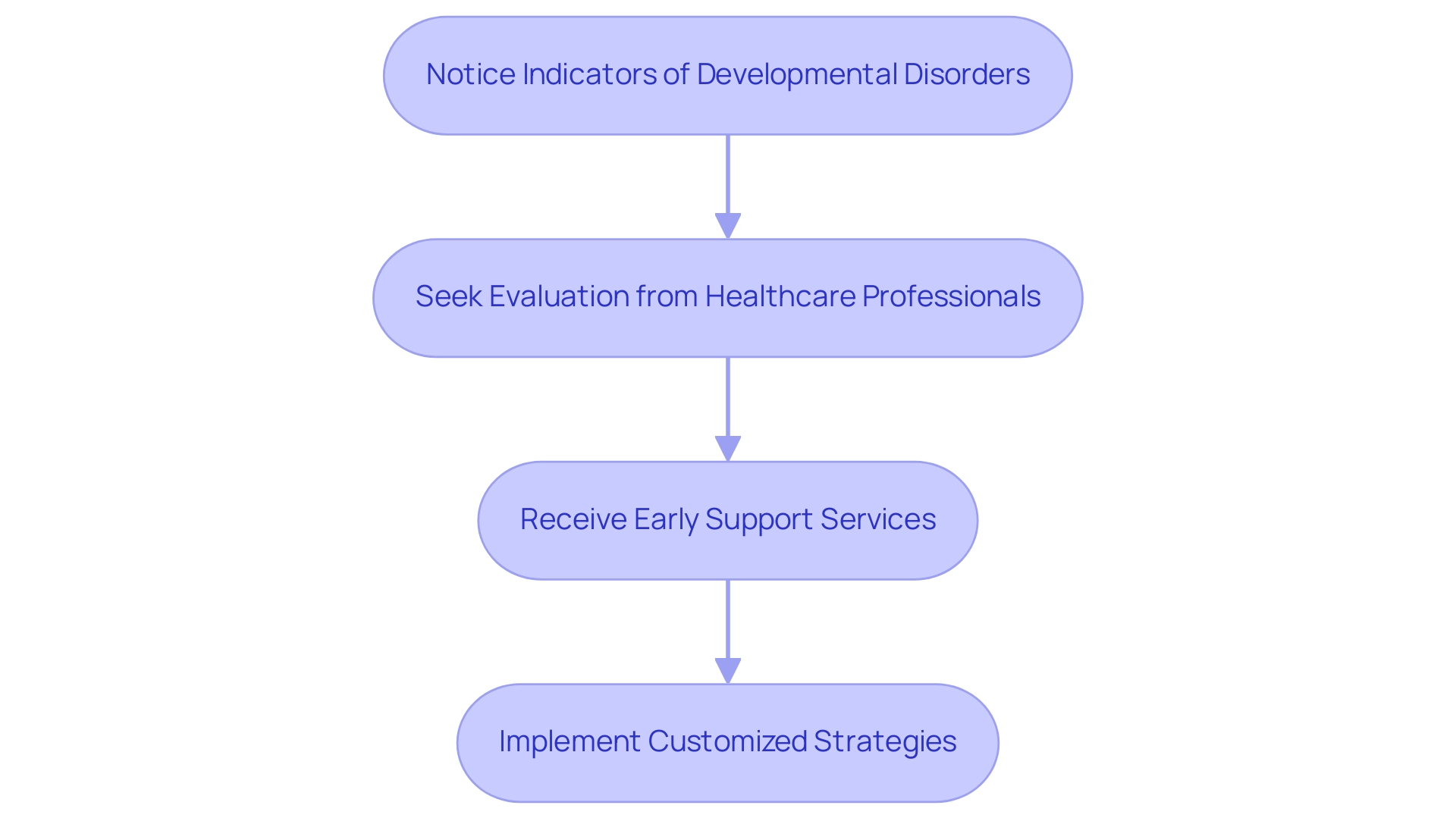
Accessing Resources and Support for Parents
Parents seeking assistance for their autistic infants have access to a wealth of resources designed to offer guidance and support. Here are some key resources that can make a significant difference:
-
Local Support Groups: Connecting with other parents through local support groups fosters a strong sense of community and shared experience. These groups can be instrumental in providing emotional support and practical advice, allowing caregivers to learn from others who understand their journey. For instance, organizations like the Autism Society offer local chapters that provide a platform for caregivers to connect and share valuable experiences.
-
Online Forums and Communities: Websites and social media groups dedicated to autism parenting are treasure troves of valuable insights and emotional support. They enable guardians to share experiences, ask questions, and receive advice from a broader community, often providing timely responses and diverse perspectives. According to the CDC, about 1 in 6 (17%) youngsters are diagnosed with a developmental disability, highlighting the importance of these supportive communities for sharing information and experiences.
-
Professional Services: Engaging with professionals such as pediatricians, therapists, and special education advocates is crucial. These specialists can assist parents in understanding their offspring's specific needs and creating a personalized action plan. Statistics indicate that early intervention can greatly enhance results for young individuals with developmental disorders; for example, the Bureau of Labor Statistics highlights that 50% of affected youth in the U.S. who access vocational rehabilitation services start those services in high school, underscoring the significance of early and continuous support.
-
Educational Resources: Parents can further their knowledge and strategies by accessing books, webinars, and workshops on autism. These educational resources provide guardians with the latest research and effective methods to assist in their offspring's development. Additionally, case studies reveal that adaptive behavior services average around $82.25, showcasing the financial aspects that guardians may need to consider while seeking help.
By utilizing these resources, guardians can create a supportive network that improves both their comprehension and their offspring's development. The impact of these resources is profound, offering a lifeline of support and knowledge that enables caregivers to advocate effectively for their autistic infants.
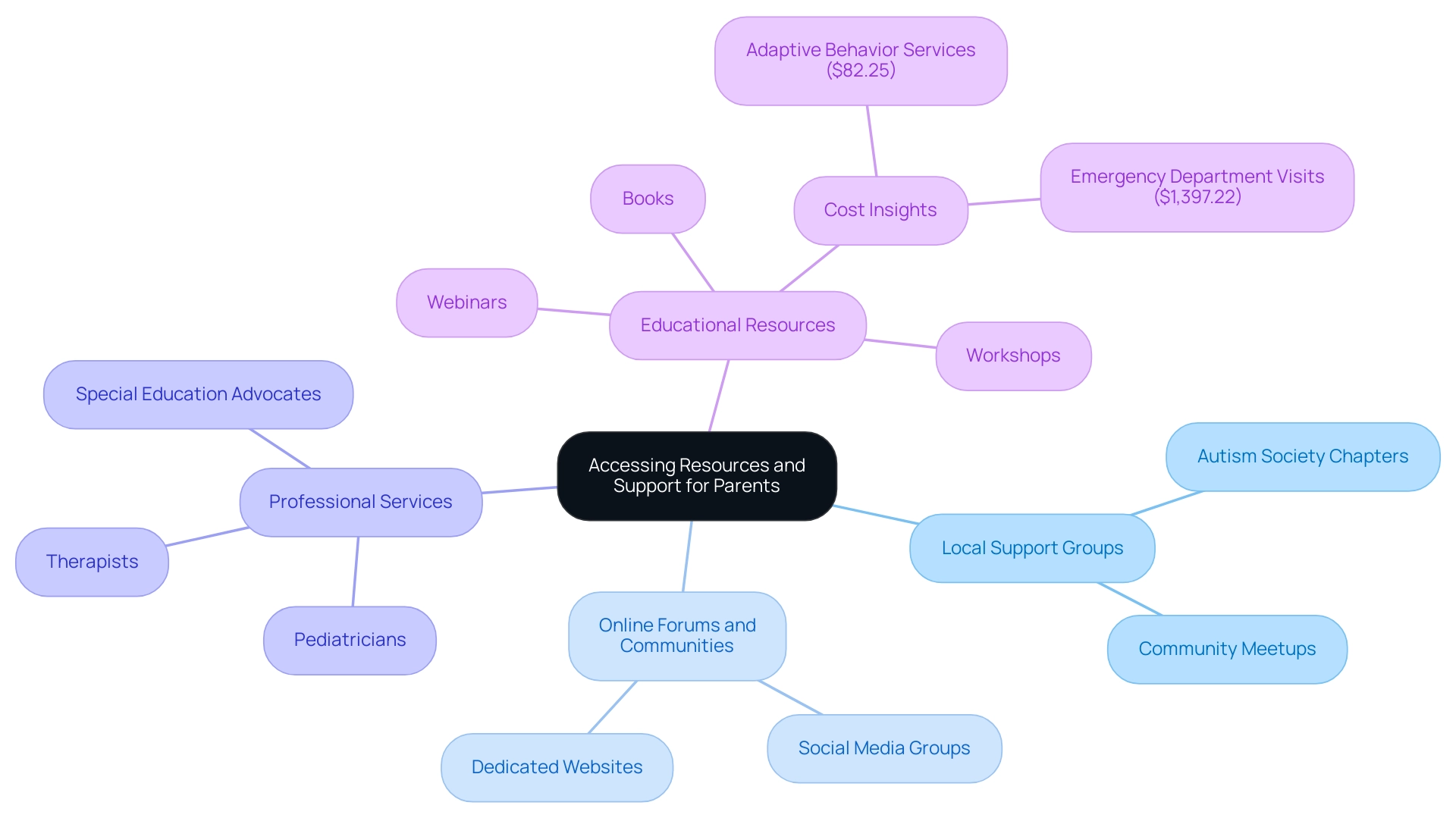
Navigating the Emotional Landscape of Autism Diagnosis
Receiving an autism diagnosis for a young one can unleash a whirlwind of emotions for guardians, ranging from confusion and fear to profound sadness. According to recent studies, 359 individuals were affected by Autism Spectrum Disorder (ASD), highlighting the prevalence of this diagnosis. It's crucial to recognize that these feelings are a normal part of the journey. As Epel wisely observes, 'Considering the impacts of chronic stress on well-being and mood, caregiving guardians require exceptional emotional support alongside the special services for their offspring.'
Parents must prioritize their emotional well-being by seeking support from friends, family, or professional counselors. Engaging in self-care practices, such as mindfulness exercises or joining support groups, can significantly help manage stress and build resilience. The sociodemographic study examining caregivers of individuals with ASD found diverse experiences, indicating that tailored support is essential for different family backgrounds.
Maintaining open communication with partners and loved ones about their feelings can ease the burden of isolation. By fostering their emotional well-being, caregivers are better prepared to assist their offspring as they navigate the complexities of autism together. This holistic approach not only empowers parents but also strengthens the family unit, fostering a supportive environment for the child's growth and development.
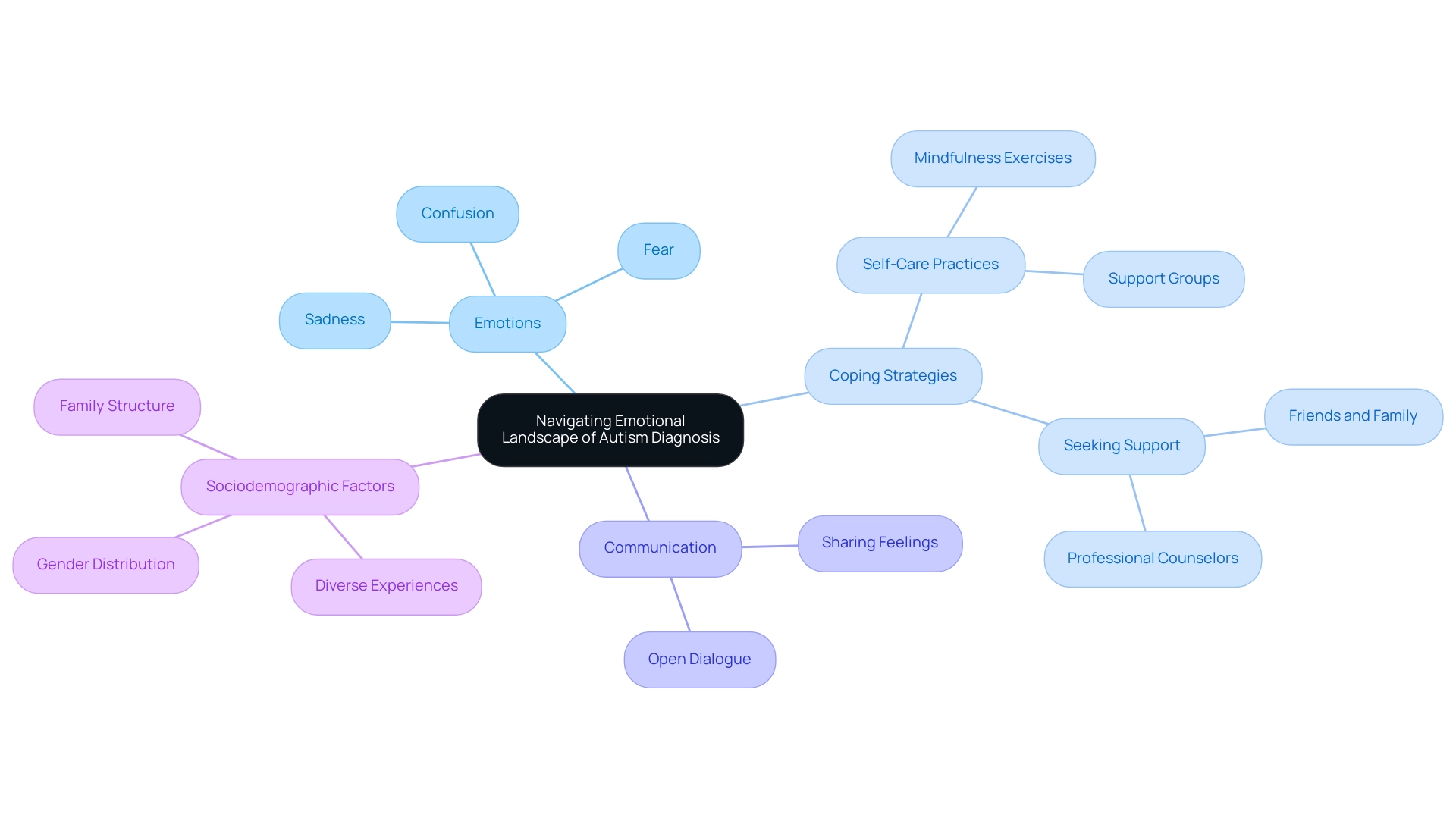
Conclusion
Recognizing the early signs of Autism Spectrum Disorder (ASD) in infants is a critical step for parents in ensuring their child's well-being and development. By being aware of key behavioral indicators—such as limited eye contact, lack of social responsiveness, and delayed communication skills—parents can take proactive measures to seek timely evaluations and interventions. The significance of early detection cannot be overstated; research consistently shows that the sooner a child receives support, the better their chances of developing essential social and communication skills.
Accessing resources and support networks is equally vital in this journey. From local support groups to professional services and online communities, parents have numerous avenues to connect with others and gain valuable insights. These resources not only provide emotional support but also empower parents to advocate effectively for their children, ensuring they receive the tailored care they need.
Moreover, navigating the emotional landscape that accompanies an autism diagnosis is essential for both parents and children. By prioritizing their own emotional health and seeking support, parents can cultivate resilience, enabling them to be the best advocates for their child's growth. In this journey, awareness, early intervention, and community support converge to create a foundation for a nurturing environment, paving the way for children to thrive despite the challenges of autism.




